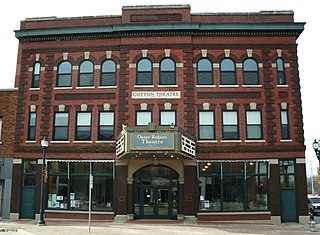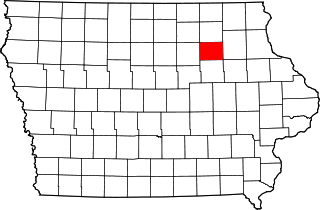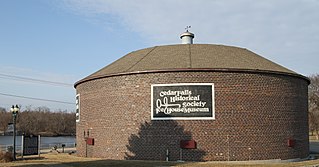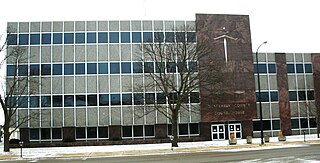
Waterloo is a city in and the county seat of Black Hawk County, Iowa, United States. As of the 2020 United States Census the population was 67,314, making it the eighth-most populous city in the state.
Black Hawk and Blackhawk may refer to:

The Cotton Theatre, also known as Regent Theatre and Oster Regent Theatre, is a theater located at the corner of 1st Street and Main Street in downtown Cedar Falls, Iowa, United States. It was named for local Cedar Falls resident Frank Cotton who built the theater in 1909 and 1910.

Here is presented a listing of the National Register of Historic Places in Black Hawk County, Iowa.

The Hotel Blackhawk is an eleven-story brick and terra cotta building located in Downtown Davenport, Iowa, United States. It is a Marriott Autograph Collection property.

This is a list of the National Register of Historic Places listings in Bremer County, Iowa.

The Mississippi Lofts and Adler Theatre is an apartment building and theater complex located in downtown Davenport, Iowa, United States. It is individually listed on the National Register of Historic Places by its original name, the Hotel Mississippi and RKO Orpheum Theater. The Hotel Mississippi was listed on the Davenport Register of Historic Properties in 2005. In 2020 the complex was included as a contributing property in the Davenport Downtown Commercial Historic District.

The Cedar Falls Independent Order of Odd Fellows Temple, in Cedar Falls, Iowa, also known as Odd Fellows Temple or 4th and Main Building, is an Independent Order of Odd Fellows building that was built during 1901–02. It is a 3+1⁄2-story building on a 46 feet (14 m) by 132 feet (40 m) base.

The Burtis–Kimball House Hotel and the Burtis Opera House were located in downtown Davenport, Iowa, United States. The hotel was listed on the National Register of Historic Places in 1979. It has since been torn down and it was delisted from the National Register in 2008. The theatre building has been significantly altered since a fire in the 1920s. Both, however, remain important to the history of the city of Davenport.

The Cedar Falls Ice House is a historic building located in Cedar Falls, Iowa, United States. It was built in 1921 and has been listed on the National Register of Historic Places since 1977. The building currently serves as the Ice House Museum.

The Black Hawk County Soldiers Memorial Hall, also known as Veterans Memorial Hall, is a Classical Revival veterans hall located at 1915 Courbat Ct. in downtown Waterloo, Black Hawk County, Iowa. It was built starting in June 1915 and first meeting was held there in December of the same year by the Grand Army of the Republic as a memorial to soldiers who died in the American Civil War. It was listed on the National Register of Historic Places in 1988 due to its architecture and importance in local history.

The Black Hawk County Courthouse is located in downtown Waterloo, Iowa, United States. It is the third dedicated courthouse to house the county's offices since it was created in 1843.

John G. Ralston was an American architect who worked out of Waterloo, Iowa. A number of his works are listed on the U.S. National Register of Historic Places for their architecture.

The Chicago Great Western Railroad-Waterloo Freight Depot is a historic building located in Waterloo, Iowa, United States. In 1887 the Chicago, St. Paul & Kansas City Railroad (CSP&KC) was the third system to enter the city, after the Illinois Central (1870) and the Burlington, Cedar Rapids and Northern Railway (1876). The CSP&KC was the first of the three to put its depots in the downtown area. Initially it built two depots in Waterloo, one on the west side of the Cedar River and one on the east side. By 1892 it had built separate passenger and freight depots along East Sixth Street. That was the same year that the CSP&KC became known as the Chicago Great Western Railroad. In 1903 the railroad built new passenger and freight depots a block south, moving them closer to the city's wholesale houses. The two-story concrete block freight depot was built on a rough limestone foundation. It features round arch freight doors and a simple wood cornice. The concrete block addition on the southeast side replaced a frame gabled structure, but its construction date is unknown. The old brick passenger depot was torn down in 1973, and the freight depot was listed on the National Register of Historic Places in 1997. In 2001 the building, which is owned by the City of Waterloo, was leased to the University of Northern Iowa for its Center for Urban Education (UNI-CUE).

The Overland Waterloo Company Building is a historic building located in Waterloo, Iowa, United States. Built in 1916 by the Corn Belt Auto Company, the four-story, brick structure housed the Northeast Iowa distributorship for Willys-Overland Motors. Designed by Waterloo architect Clinton P. Shockley, it features brick and terra cotta pilasters, terra cotta plaques with swag motif, molding, and a balconet. The first floor housed the sales offices and a service garage. The second floor was occupied by a clubroom/lounge, a display room for used cars, a battery-charging room, a workroom, stockroom, shop and employees' room. The third and fourth floors were used to store automobiles to be delivered to dealers and customers. Corn Belt lost their distributorship by way of a corporate restructuring in 1921, but maintained an Overland dealership here until 1927 when they moved to a different building. The building housed other automobile related business until 1955. In that year KWWL radio and KWWL-TV moved into the main floor and other businesses occupied the other floors. Black Hawk Broadcasting Company, which owned the stations, converted the entire building for use as a broadcast facility in 1965. The building continues to function for that purpose. It was listed on the National Register of Historic Places in 2014.

The Cedar Falls Historic District is a nationally recognized historic district located in Cedar Falls, Iowa, United States. It was listed on the National Register of Historic Places in 2017. It is made up of 59 buildings that were constructed between 1860 and 1960. Of those, 46 were determined to be significantly historic. Four of the buildings were individually listed on the National Register of Historic Places in previous years; they include the Black Hawk Hotel (1870), the Odd Fellows Temple (1902), and the Oster Regent Theater (1910).

The Hotel President, also known as the Park Towers Apartments, is an historic building located in downtown Waterloo, Iowa, United States. The building was completed in 1929, and it opened as a "showcase hotel." In 1948, Paul "Pinkie" George and five other wrestling promoters from the Midwest founded the National Wrestling Alliance in the hotel. The manager of the hotel at the time was Lark Gable, the grandfather of Olympic gold medal winner Dan Gable. Various companies owned and operated the hotel until it was acquired in 1968 by Elders Inc., a nonprofit group of churches. They converted the building into subsidized housing. It was bought by local developers Brent Dahlstrom and Jim Sulentic in 2011 and they sold it to Huntley Witmer Development of Los Angeles. Huntley Witmer spent $12 million in 2015 renovating the building that continues to house 84 units of federally subsidized housing. It was listed on the National Register of Historic Places in 2017.

The Daniel and Margaret Wild House is a historic building located in Cedar Falls, Iowa, United States. Designed by William A. Robinson, the two-story frame Queen Anne was completed in 1895. It features a rooftop porch turret, pink granite foundation, and the use of exotic woods such as circassian walnut and Georgia curly pine. The house was built for Daniel and Margaret Wild and their family. Daniel Wild was a German immigrant who settled in Cedar Falls in 1853, the same year he married Margaret. He owned a brick company by 1868 and then expanded into lumber, coal, farming and rest estate. The house was listed on the National Register of Historic Places in 2017.

The old Cedar Falls Post Office is an historic building located in Cedar Falls, Iowa, United States. Completed in 1918, this was the city's first federal government building, and Black Hawk County became the only county in the state with two post offices that reported directly to the United States Post Office Department. It was built at the time when the design of federal building's were controlled by the Department of the Treasury. This building was designed by James A. Wetmore, who was the Acting Supervising Architect of the U.S. Office of the Supervising Architect. It was built by Des Moines contractor Frederick C. Weitz. The single-story Neoclassical brick structure features a symmetrical facade, a slightly recessed central bay, a round-arched entryway flanked by round arched windows, and Bedford stone trim.

The Waterloo East Commercial Historic District is a nationally recognized historic district located in Waterloo, Iowa, United States. It was listed on the National Register of Historic Places in 2011. At the time of its nomination the district consisted of 36 resources, including 28 contributing buildings, and eight non-contributing buildings. The city of Waterloo was established in the early 1850s. Its first settlers started developing the west side of the city before crossing the Cedar River and developing east side. The first Black Hawk County Courthouse was built on the east side in 1856 and East Waterloo Township was created two years later. As industry began to develop along the river, and the arrival of the first railroad in 1861, the commercial district on the east side began to grow. Also on the east side of town was the terminus of the streetcar-turned-interurban system. By 1900, the city became one of the primary wholesale and retail centers in northeastern Iowa. In 1911 the Black population increased significantly as workers, primarily from Mississippi, moved into town to work for the Illinois Central Railroad. The following year the saloons in town were closed and bootlegging, gambling, drugs, and prostitution started to increase in the area surrounding the central business district. All of these developed put together created the atmosphere of the downtown commercial district.





















